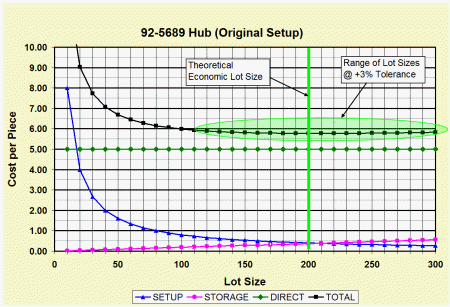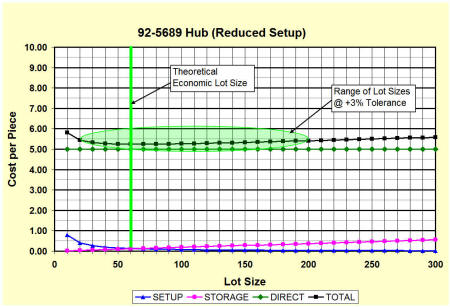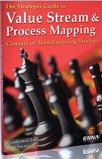|

Make-To-Stock Original Setup
In this analysis, an MTS machined part shows an optimum
lot size of 200 units at a minimum Total Cost of $5.775.
However, the costs used in this analysis are inexact by
nature. Particularly the storage costs that are usually elusive, part of overhead and must be
allocated by an inexact formula. In addition, there are many benefits in small lots that have
not been captured by this analysis. Recognizing these inaccuracies, we might allow a tolerance
on the total cost of, say, 3% and this is very conservative.
With a 3% tolerance there is a range of lot sizes
available from 110 pieces up to 450 pieces. Given the advantages of small lots, the analysis
would now indicate an optimum lot size of about 110 units.
Make-To-Stock Reduced Setup
-
ELS=60
-
Lowest Total Cost=$5.246
-
Lot Size Range= 20-200
|
With a 90% reduction in setup cost, the optimum batch becomes 20 units. Using a 3% deviation
from optimum, the range becomes 20-200 units.
|

Implications of This Analysis
If the original ELS is taken at face value (200 units) the minimum average inventory would be
100 units. However uncertainty of demand and other variations would dictate a much larger
average
inventory.
With setup reduction the ELS is only 60 units. If this ELS is taken at face value, average
minimum inventory would drop by 70%. However, the range of lot sizes has increased greatly and
this leads to even more flexibility. Lot sizes from 20-200 units are now feasible.
Taking the minimum lot sizes from the range both before and after setup reduction (110 and
20) the inventory reduction would be 80%.
One highly important but intangible benefit is the reduction of stockouts. For companies that
deliver from stock, a stockout represents more than just a lost sale. It can also lose customers
and affect many possible future sales.
In the short term, these kinds of improvements represent localized cost savings. In the
longer term, extended to other products, they can have major positive effects for facility,
finance and marketing strategies. They can increase growth while
providing the capital and space required for that growth.
|





